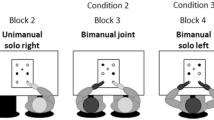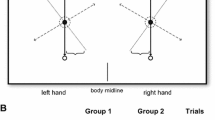Abstract
In two experiments bimanual movements with various combinations of target directions were studied by means of the timed-response procedure. The findings revealed an adaptive modulation of intermanual interactions during direction specifications depending on particular target directions. For symmetric movements intermanual correlations of movement directions are positive, indicating a symmetric coupling. For parallel movements the positive intermanual correlations, observed at short preparation intervals, turn into negative correlations as the time available for motor preparation increases. Biases of mean directions, that can be observed for movements to targets with different eccentricities, reflect one or the other kind of coupling, symmetrical for symmetric target directions and parallel for parallel target directions. These biases are static, that is, they are present at long preparation times, and they are phasically enhanced at shorter preparation intervals. The task-adaptive modulation of intermanual interactions is superposed on a basic symmetry bias.











Similar content being viewed by others
Notes
The different effects of measurement noise on the intermanual correlations of terminal and initial directions result from the different ranges of coordinates and can easily be illustrated by way of simulation. We generated two sets of correlated normally distributed directions (μ=30, σ2=5 ρ=0.8). For each direction we determined the x- and y-coordinates for vector lengths of 20 and 150 mm. These coordinates were rounded to units of 0.5 mm, corresponding to the coordinates used in the determination of initial and terminal directions in the experiment. For each length the directions were re-computed from the rounded coordinates. For a typical sample of 1000 cases the means were 29.98° and 30.02° for the left and right hand, respectively, the standard deviations were 2.22 and 2.25°, and the intermanual correlation was 0.8048. Means (and standard deviations) for the re-computed terminal directions were 29.98° (2.22°) and 30.02° (2.25°) with a correlation of 0.8050; means (and standard deviations) for the re-computed initial directions were 29.96° (2.25°) and 30.03° (2.30°) with a correlation of 0.7751. The differences in standard deviations and correlations are consistent across samples, but not the difference in the means.
References
Cattaert D, Semjen A, Summers JJ (1999) Simulating a neural cross-talk model for between-hand interference during bimanual circle drawing. Biol Cybern 81:343–358
Desmurget M, Grafton S, Vindras P, Grea H, Turner RS (2003) Basal ganglia network mediates the control of movement amplitude. Exp Brain Res 153:197–209
Diedrichsen J, Hazeltine E, Kennerley S, Ivry RB (2001) Moving to directly cued locations abolishes spatial interference during bimanual actions. Psychol Sci 12:493–498
Donchin O, Cardoso de Oliveira S (2004) Electrophysiological approaches to bimanual coordination in primates. In: Swinnen SP, Duysens J (eds) Neuro-behavioral determinants of interlimb coordination. Kluwer, Norwell, Mass, pp 131–153
Fu Q-G, Suarez JI, Ebner TJ (1993) Neuronal specification of direction and distance during reaching movements in the superior precentral motor area and primary motor cortex of monkeys. J Neurophysiol 70:2097–2116
Fu Q-G, Flament D, Coltz JD, Ebner TJ (1995) Temporal encoding of movement kinematics in the discharge of primate motor and premotor neurons. J Neurophysiol 73:836–854
Ghez C, Favilla M, Ghilardi MF, Gordon J, Bermejo R, Pullman S (1997) Discrete and continuous planning of hand movements and isometric force trajectories. Exp Brain Res 115:217–233
Gordon J, Ghilardi MF, Cooper SE, Ghez C (1994) Accuracy of planar reaching movements. II. Systematic extent errors resulting from inertial anisotropy. Exp Brain Res 99:112–130
Gordon J, Ghilardi MF, Ghez C (1994) Accuracy of planar reaching movements. I. Independence of direction and extent variability. Exp Brain Res 99:97–111
Hening W, Favilla M, Ghez C (1988) Trajectory control in targeted force impulses. V. Gradual specification of response amplitude. Exp Brain Res 71:116–128
Heuer H (1990) Rapid responses with the left or right hand: response–response compatibility effects due to intermanual interactions. In: Proctor RW, Reeve TG (eds) Stimulus-response compatibility: An integrated perspective. North-Holland, Amsterdam, pp 311–342
Heuer H (1993) Structural constraints on bimanual movements. Psychol Res 55:83–98
Heuer H (1996) Coordination. In: Heuer H, Keele SW (eds) Handbook of Perception and Action. Vol. 2: Motor skills. Academic Press, London, pp 121–180
Heuer H, Klein W (2005) Intermanual interactions in discrete and periodic bimanual movements with same and different amplitudes. Exp Brain Res
Heuer H, Spijkers W, Kleinsorge T, van der Loo H, Steglich C (1998) The time course of cross-talk during the simultaneous specification of bimanual movement amplitudes. Exp Brain Res 118:381–392
Heuer H, Kleinsorge T, Spijkers W, Steglich C (2001) Static and phasic cross-talk effects in discrete bimanual reversal movements. J Mot Behav 33:67–85
Huttenlocher J, Hedges LV, Duncan S (1991) Categories and particulars: prototype effects in estimating spatial location. Psychol Rev 98:352–376
Kakei S, Hoffman DS, Strick PL (2003) Sensorimotor transformations in cortical motor areas. Neurosci Res 46:1–10
Kelso JAS, Southard DL, Goodman D (1979) On the coordination of two-handed movements. J Exp Psychol Hum Percept Perform 5:229–238
Kleinsorge T, Heuer H (1999) Hierarchical switching in a multi-dimensional task space. Psychol Res 62:300–312
Krakauer JW, Ghilardi MF, Mentis M, Barnes A, Veytsman M, Eidelberg D, Ghez C (2004) Differential cortical and subcortical activations in learning rotations and gains for reaching: a PET study. J Neurophysiol 91:924–933
Levin O, Ouamer M, Steyvers M, Swinnen SP (2001) Directional tuning effects during cyclical two-joint arm movements in the horizontal plane. Exp Brain R 141:471–484
Logan GD (2003) Simon-type effects: Chronometric evidence for keypress schemata in typewriting. J Exp Psychol Hum Percept Perform 29:741–757
Marteniuk RG, MacKenzie CL, Baba DM (1984) Bimanual movement control: Information processing and interaction effects. Q J Exp Psychol 36A:335–365
Massion J (1992) Movement, posture, and equilibrium: Interaction and coordination. Prog Neurobiol 38:35–56
Mechsner F, Kerzel D, Knoblich G, Prinz W (2001) Perceptual basis of coordination. Nature 414:69–73
Merz F, Kalveram K-Th (1965) Kritik der Differenzierungshypothese der Intelligenz. Arch Gesamte Psychol 117:287–295
Messier J, Kalaska JF (1999) Comparison of variability of initial kinematics and endpoints of reaching movements. Exp Brain Res 125:139–152
Preilowski B (1975) Bilateral motor interaction: Perceptual-motor performance of partial and complete “split-brain” patients. In: Zülch KJ, Creutzfeldt O, Galbraith GG (eds) Cerebral localization. Springer, Berlin Heidelberg New York pp 115–132
Rinkenauer G, Ulrich R, Wing AM (2001) Brief bimanual force pulses: correlations between the hand in force and time. J Exp Psychol Hum Percept Perform 27:1485–1497
Rogers RD, Monsell S (1995) The cost of a predictable switch between simple cognitive tasks. J Exp Psychol Gen 124:207–231
Rossetti Y, Desmurget M, Prablanc C (1995) Vector coding of movement: vision, proprioception, or both? J Neurophysiol 74:457–463
Sherwood DE (1990) Practice and assimilation effects in a multilimb aiming task. J Mot Behav 22:267–291
Sherwood DE (1991) Distance and location assimilation in rapid bimanual movement. Res Q Exerc Sport 62:302–308
Sherwood DE (1994a) Interlimb amplitude differences, spatial assimilations, and the temporal structure of rapid bimanual movements. Hum Mov Sci 13:841–860
Sherwood DE (1994b) Hand preference, practice order, and spatial assimilations in rapid bimanual movement. J Mot Behav 26:123–134
Sherwood DE, Nishimura KM (1992) EMG amplitude and spatial assimilation effects in rapid bimanual movement. Res Q Exerc Sport 63:284–291
Spijkers W, Heuer H (2004) Behavioral principles of interlimb coordination. In: Swinnen SP, Duysens J (eds) Neuro-behavioral determinants of interlimb coordination. Kluwer, Norwell, Mass, pp 223–258
Spijkers W, Heuer H (1995) Structural constraints on the performance of symmetrical bimanual movements with different amplitudes. Q J Exp Psychol 48A:716–740
Steglich C (2002) Experimentelle Untersuchungen zur bimanuellen Koordination als transiente Kopplung bei der Richtungsspezifikation. Unpublished Dissertation, RWTH Aachen
Steglich C, Heuer H, Spijkers W, Kleinsorge T (1999) Bimanual coupling during the specification of isometric forces. Exp Brain Res 129:302–316
Swinnen SP, Dounskaia N, Levin O, Duysens J (2001) Constraints during bimanual coordination: the role of direction in relation to amplitude and force requirements. Behav Brain Res 123:201–218
Swinnen SP, Dounskaia N, Duysens J (2002) Patterns of bimanual interference reveal movement encoding within a radial egocentric reference frame. J Cogn Neurosci 14:463–471
Swinnen SP, Puttemans V, Vangheluwe S, Wenderoth N, Levin O, Dounskaia N (2003) Directional interference during bimanual coordination: is interlimb coupling mediated by afferent or efferent processes. Behav Brain Res 139:177–195
Thoroughman KA, Shadmehr R (1999) Electromyographic correlates of learning internal models of reaching movements. J Neurosci 19:8573–8588
Vindras P, Viviani P (2002) Altering the visuomotor gain. Evidence that motor plans deal with vector quantities. Exp Brain Res 147:280–295
Weigelt M (2004) Target-related coupling in bimanual coordination. Unpublished Dissertation. LMU Munich
Wenderoth N, Debaere F, Sunaert S, van Hecke P, Swinnen SP (2004) Parieto-premotor areas mediate directional interference during bimanual movements. Cereb Cortex 14:1153–1163
Wenderoth N, Debaere F, Sunaert S, Swinnen SP (2005) Spatial interference during bimanual coordination: differential brain networks associated with control of movement amplitude and direction. Hum Brain Mapp 26:286–300
Acknowledgements
The research reported in this paper was supported by grant HE 1187/14-1 of the Deutsche Forschungsgemeinschaft. We thank Barbara Herbst, Holger Küper, Kevin Schepers, Henning Stracke, and Petra Wallmeyer for their support in running the experiments, and Thomas Kleinsorge, Stephan Swinnen, and two anonymous reviewers for helpful comments on earlier versions of this paper.
Author information
Authors and Affiliations
Corresponding author
Rights and permissions
About this article
Cite this article
Heuer, H., Klein, W. The modulation of intermanual interactions during the specification of the directions of bimanual movements. Exp Brain Res 169, 162–181 (2006). https://doi.org/10.1007/s00221-005-0135-6
Received:
Accepted:
Published:
Issue Date:
DOI: https://doi.org/10.1007/s00221-005-0135-6




